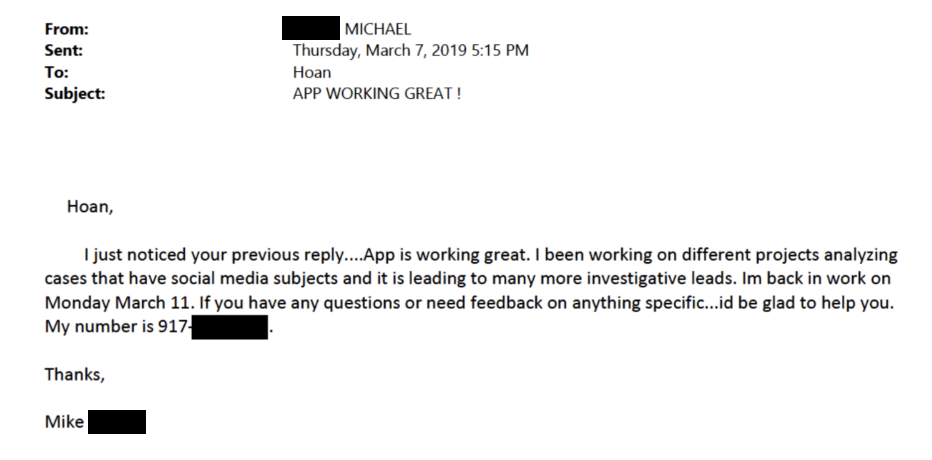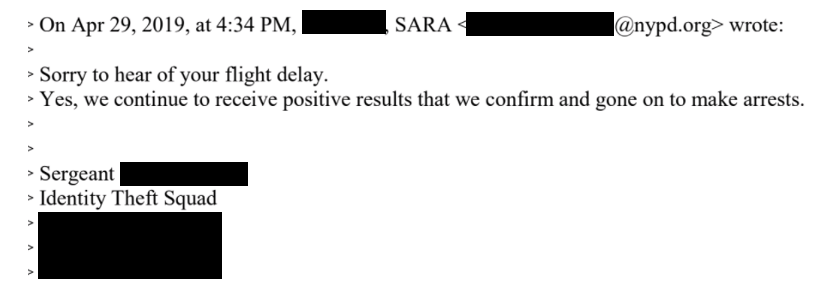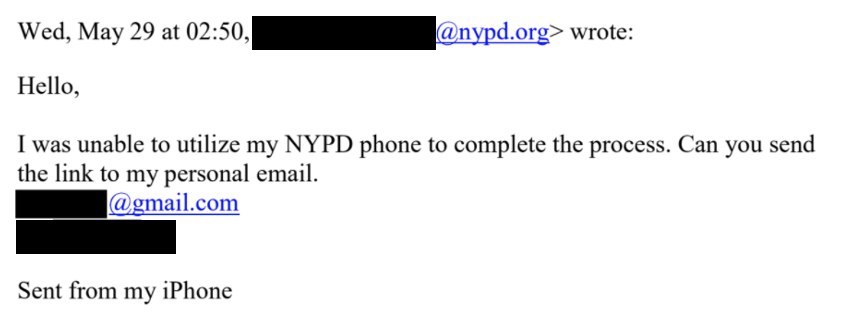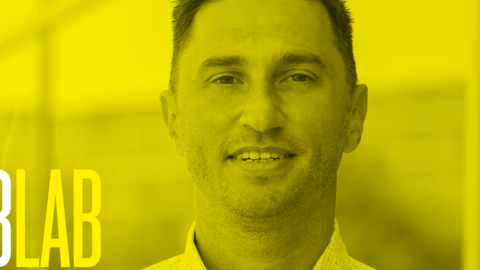The emails span a period from October 2018 through February 2020, beginning when Clearview AI CEO Hoan Ton-That was introduced to NYPD deputy inspector Chris Flanagan. After initial meetings, Clearview AI entered into a vendor contract with NYPD in December 2018 on a trial basis that lasted until the following March.
The documents show that many individuals at NYPD had access to Clearview during and after this time, from department leadership to junior officers. Throughout the exchanges, Clearview AI encouraged more use of its services. (“See if you can reach 100 searches,” its onboarding instructions urged officers.) The emails show that trial accounts for the NYPD were created as late as February 2020, almost a year after the trial period was said to have ended.
We reviewed the emails, and talked to top surveillance and legal experts about their contents. Here’s what you need to know.
NYPD lied about the extent of its relationship with Clearview AI and the use of its facial recognition technology
The NYPD told BuzzFeed News and the New York Post previously that it had “no institutional relationship” with Clearview AI, “formally or informally.” The department did disclose that it had trialed Clearview AI, but the emails show that the technology was used over a sustained time period by a large number of people who completed a high volume of searches in real investigations.
In one exchange, a detective working in the department’s facial recognition unit said, “App is working great.” In another, an officer on the NYPD’s identity theft squad said that “we continue to receive positive results” and have “gone on to make arrests.” (We have removed full names and email addresses from these images; other personal details were redacted in the original documents.)


Albert Fox Cahn, executive director at the Surveillance Technology Oversight Project, a nonprofit that advocates for the abolition of police use of facial recognition technology in New York City, says the records clearly contradict NYPD’s previous public statements on its use of Clearview AI.
“Here we have a pattern of officers getting Clearview accounts—not for weeks or months, but over the course of years,” he says. “We have evidence of meetings with officials at the highest level of the NYPD, including the facial identification section. This isn’t a few officers who decide to go off and get a trial account. This was a systematic adoption of Clearview’s facial recognition technology to target New Yorkers.”
Further, NYPD’s description of its facial recognition use, which is required under a recently passed law, says that “investigators compare probe images obtained during investigations with a controlled and limited group of photographs already within possession of the NYPD.” Clearview AI is known for its database of over 3 billion photos scraped from the web.
NYPD is working closely with immigration enforcement, and officers referred Clearview AI to ICE
The documents contain multiple emails from the NYPD that appear to be referrals to aid Clearview in selling its technology to the Department of Homeland Security. Two police officers had both NYPD and Homeland Security affiliations in their email signature, while another officer identified as a member of a Homeland Security task force.
“There just seems to be so much communication, maybe data sharing, and so much unregulated use of technology.”
New York is designated as a sanctuary city, meaning that local law enforcement limits its cooperation with federal immigration agencies. In fact, NYPD’s facial recognition policy statement says that “information is not shared in furtherance of immigration enforcement” and “access will not be given to other agencies for purposes of furthering immigration enforcement.”
“I think one of the big takeaways is just how lawless and unregulated the interactions and surveillance and data sharing landscape is between local police, federal law enforcement, immigration enforcement,” says Matthew Guariglia, an analyst at the Electronic Frontier Foundation. “There just seems to be so much communication, maybe data sharing, and so much unregulated use of technology.”
Cahn says the emails immediately ring alarm bells, particularly since a great deal of law enforcement information funnels through central systems known as fusion centers.
“You can claim you’re a sanctuary city all you want, but as long as you continue to have these DHS task forces, as long as you continue to have information fusion centers that allow real-time data exchange with DHS, you’re making that promise into a lie.”
Many officers asked to use Clearview AI on their personal devices or through their personal email accounts
At least four officers asked for access to Clearview’s app on their personal devices or through personal emails. Department devices are closely regulated, and it can be difficult to download applications to official NYPD mobile phones. Some officers clearly opted to use their personal devices when department phones were too restrictive.

Clearview replied to this email, “Hi William, you should have a setup email in your inbox shortly.”
Jonathan McCoy is a digital forensics attorney at Legal Aid Society and took part in filing the freedom of information request. He found the use of personal devices particularly troublesome: “My takeaway is that they were actively trying to circumvent NYPD policies and procedures that state that if you’re going to be using facial recognition technology, you have to go through FIS (facial identification section) and they have to use the technology that’s already been approved by the NYPD wholesale.” NYPD does already have a facial recognition system, provided by a company called Dataworks.



Recent Comments